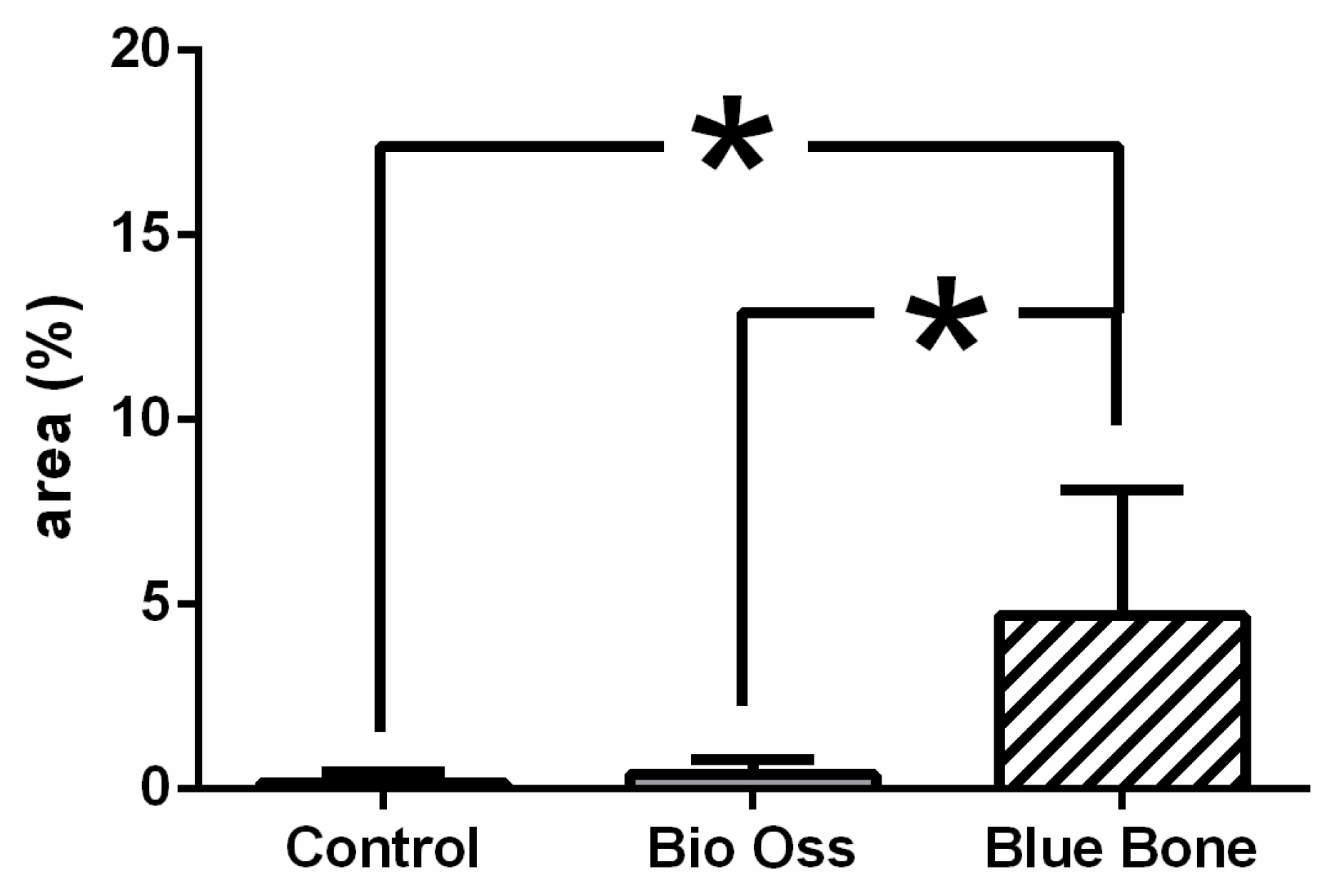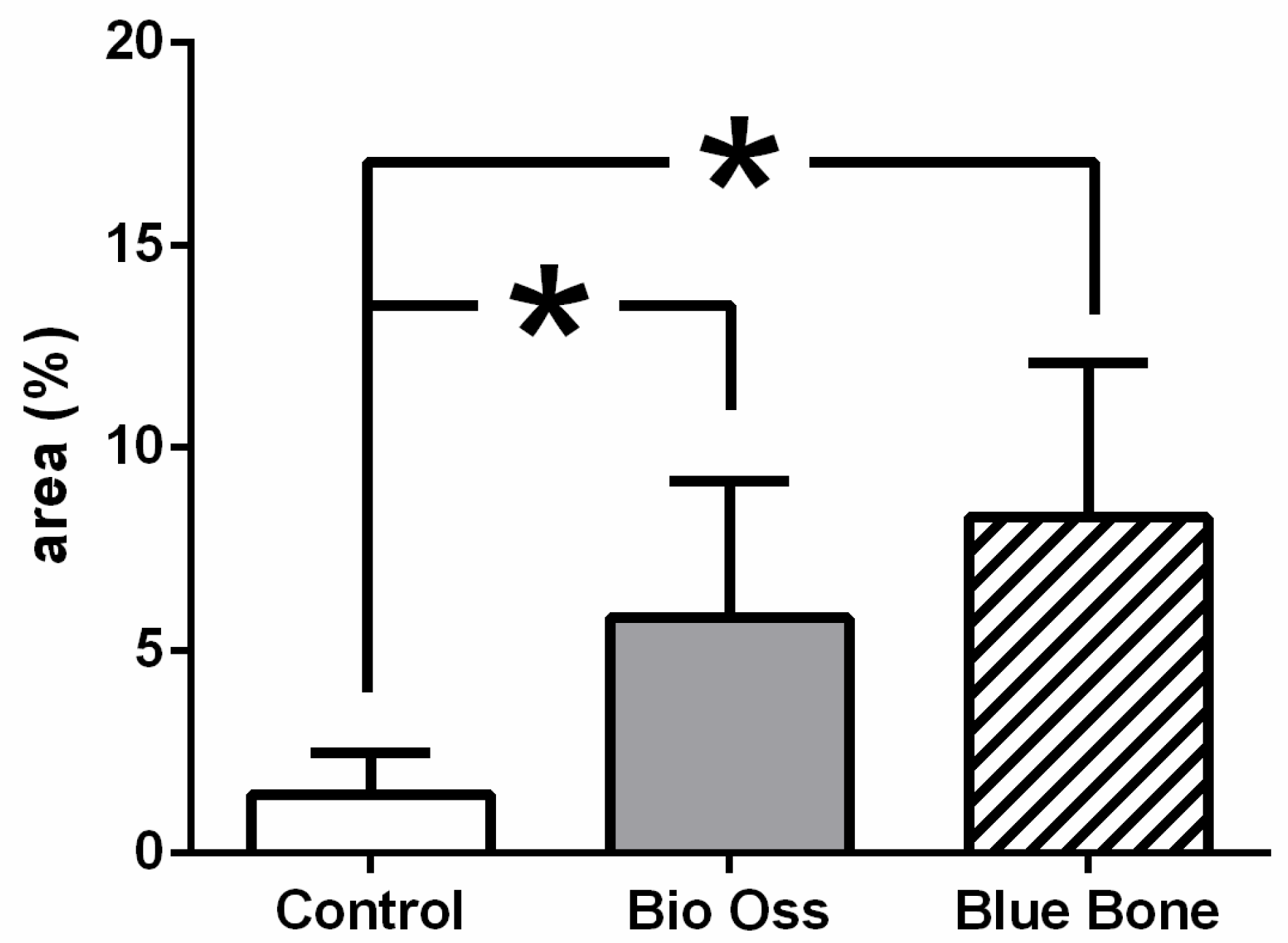Osteopontin and Vascular Endothelial Growth Factor-Immunoreactivity in Critical Bone Defects Matrix Production: A Nano-Hydroxyapatite/Beta-Tricalcium Phosphate and Xenogeneic Hydroxyapatite Comparison
Abstract
:1. Introduction
2. Materials and Methods
2.1. Animals
2.2. Surgical Procedures
2.3. Distribution of Groups
2.4. Morphological Analysis Protocol
2.5. Goldner’s Trichromic Staining Protocol
2.6. Vascular Endothelial Growth Factor (VEGF) and Osteopomtin (OPN) Immunoreactivity
2.6.1. Histochemical Protocol
2.6.2. Image Acquisition and Histomorphometry
2.6.3. Statistical Analysis
3. Results
3.1. Goldner’s Trichromic Staining
3.2. Osteopontin
3.3. Vascular Endothelial Growth Factor (VEGF)
4. Discussion
5. Conclusions
- a.
- Synthetic nano-hydroxyapatite had more significant relevance in the formation of newly formed bone matrix compared to xenogeneic hydroxyapatite and clot groups.
- b.
- The rate of the protein that promotes the growth of new blood vessels (VEGF) was higher in the nano-hydroxyapatite group than in the other groups.
- c.
- The response of the extracellular matrix protein (osteopontin) was similar in the synthetic nano-hydroxyapatite and xenogeneic hydroxyapatite groups compared to the control group.
Author Contributions
Funding
Conflicts of Interest
References
- Li, N.; Wu, G.; Yao, H.; Tang, R.; Gu, X.; Tu, C. Size effect of nano-hydroxyapatite on proliferation of odontoblast-like MDPC-23 cells. Dent. Mater. J. 2019, 38, 534–539. [Google Scholar] [CrossRef] [Green Version]
- Marycz, K.; Smieszek, A.; Targonska, S.; Walsh, S.A.; Szustakiewicz, K.; Wiglusz, R.J. Three dimensional (3D) printed polylactic acid with nano-hydroxyapatite doped with europium(III) ions (nHAp/PLLA@Eu3+) composite for osteochondral defect regeneration and theranostics. Mater. Sci. Eng. C Mater. Biol. Appl. 2020, 110, 110634. [Google Scholar] [CrossRef]
- Da Silva Brum, I.; de Carvalho, J.J.; da Silva Pires, J.L.; de Carvalho, M.A.A.; Dos Santos, L.B.F.; Elias, C.N. Nanosized hydroxyapatite and β-tricalcium phosphate composite: Physico-chemical, cytotoxicity, morphological properties and in vivo trial. Sci. Rep. 2019, 9, 19602. [Google Scholar] [CrossRef]
- Da Silva Brum, I.; Frigo, L.; Lana Devita, R.; da Silva Pires, J.L.; Hugo Vieira de Oliveira, V.; Rosa Nascimento, A.L.; de Carvalho, J.J. Histomorphometric, Immunohistochemical, Ultrastructural Characterization of a Nano-Hydroxyapatite/Beta-Tricalcium Phosphate Composite and a Bone Xenograft in Sub-Critical Size Bone Defect in Rat Calvaria. Materials 2020, 13, 4598. [Google Scholar] [CrossRef]
- De Oliveira Junior, J.M.; Montagner, P.G.; Carrijo, R.C.; Martinez, E.F. Physical characterization of biphasic bioceramic materials with different granulation sizes and their influence on bone repair and inflammation in rat calvaria. Sci. Rep. 2021, 11, 4484. [Google Scholar] [CrossRef]
- Wang, X.; Li, G.; Guo, J.; Yang, L.; Liu, Y.; Sun, Q.; Li, R.; Yu, W. Hybrid composites of mesenchymal stem cell sheets, hydroxyapatite, and platelet-rich fibrin granules for bone regeneration in a rabbit calvarial critical-size defect model. Exp. Ther. Med. 2017, 13, 1891–1899. [Google Scholar] [CrossRef] [Green Version]
- Brum, I.S.; Elias, C.N.; de Carvalho, J.J.; Pires, J.L.; Pereira, M.J.; de Biasi, R.S. Properties of a bovine collagen type I membrane for guided bone regeneration applications. e-Polymers 2021, 21, 210–221. [Google Scholar] [CrossRef]
- Wang, Z.; Hu, H.; Li, Z.; Weng, Y.; Dai, T.; Zong, C.; Liu, Y.; Liu, B. Sheet of osteoblastic cells combined with platelet-rich fibrin improves the formation of bone in critical-size calvarial defects in rabbits. Br. J. Oral. Maxillofac. Surg. 2016, 54, 316–321. [Google Scholar] [CrossRef] [PubMed]
- Jin, H.; Zhang, K.; Qiao, C.; Yuan, A.; Li, D.; Zhao, L.; Shi, C.; Xu, X.; Ni, S.; Zheng, C.; et al. Efficiently engineered cell sheet using a complex of polyethylenimine-alginate nanocomposites plus bone morphogenetic protein 2 gene to promote new bone formation. Int. J. Nanomed. 2014, 9, 2179–2190. [Google Scholar]
- França, R.; Samani, T.D.; Bayade, G.; Yahia, L.; Sacher, E. Nanoscale surface characterization of biphasic calcium phosphate, with comparisons to calcium hydroxyapatite and β-tricalcium phosphate bioceramics. J. Colloid Interface Sci. 2014, 420, 182–188. [Google Scholar] [CrossRef] [PubMed]
- Dey, R.E.; Wimpenny, I.; Gough, J.E.; Watts, D.C.; Budd, P.M. Poly (vinylphosphonic acid-co-acrylic acid) hydrogels: The effect of copolymer composition on osteoblast adhesion and proliferation. J. Biomed. Mater. Res. A 2018, 106, 255–264. [Google Scholar] [CrossRef] [Green Version]
- Joshi, S.; Mahadevan, G.; Verma, S.; Valiyaveettil, S. Bioinspired adenine-dopamine immobilized polymer hydrogel adhesives for tissue engineering. Chem. Commun. (Camb.) 2020, 56, 11303–11306. [Google Scholar] [CrossRef]
- Lee, J.H.; Ryu, M.Y.; Baek, H.R.; Lee, K.M.; Seo, J.H.; Lee, H.K. Fabrication and evaluation of porous beta-tricalcium phosphate/hydroxyapatite (60/40) composite as a bone graft extender using rat calvarial bone defect model. Sci. World J. 2013, 2013, 481789. [Google Scholar] [CrossRef]
- Gruber, H.E. Adaptations of Goldner’s Masson trichrome stain for the study of undecalcified plastic embedded bone. Biotech. Histochem. 1992, 67, 30–34. [Google Scholar] [CrossRef]
- Du, B.; Liu, W.; Deng, Y.; Li, S.; Liu, X.; Gao, Y.; Zhou, L. Angiogenesis and bone regeneration of porous nano-hydroxyapatite/coralline blocks coated with rhVEGF165 in critical-size alveolar bone defects in vivo. Int. J. Nanomed. 2015, 10, 2555–2565. [Google Scholar] [CrossRef] [Green Version]
- Dreyer, C.H.; Kjaergaard, K.; Ding, M.; Qin, L. Vascular endothelial growth factor for in vivo bone formation: A systematic review. J. Orthop. Translat. 2020, 24, 46–57. [Google Scholar] [CrossRef]
- Lytkina, D.; Gutsalova, A.; Fedorishin, D.; Korotchenko, N.; Akhmedzhanov, R.; Kozik, V.; Kurzina, I. Synthesis and Properties of Zinc-Modified Hydroxyapatite. J. Funct. Biomater. 2020, 11, 10. [Google Scholar] [CrossRef] [Green Version]
- Hu, J.; Yang, Z.; Zhou, Y.; Liu, Y.; Li, K.; Lu, H. Porous biphasic calcium phosphate ceramics coated with nano-hydroxyapatite and seeded with mesenchymal stem cells for reconstruction of radius segmental defects in rabbits. J. Mater. Sci. Mater. Med. 2015, 26, 257. [Google Scholar] [CrossRef] [PubMed]
- De Witte, T.M.; Fratila-Apachitei, L.E.; Zadpoor, A.A.; Peppas, N.A. Bone tissue engineering via growth factor delivery: From scaffolds to complex matrices. Regen. Biomater. 2018, 5, 197–211. [Google Scholar] [CrossRef] [Green Version]
- Gaihre, B.; Liu, X.; Li, L.; Lee Miller Ii, A.; Camilleri, E.T.; Li, Y.; Waletzki, B.; Lu, L. Bifunctional hydrogel for potential vascularized bone tissue regeneration. Mater. Sci. Eng. C Mater. Biol. Appl. 2021, 124, 112075. [Google Scholar] [CrossRef] [PubMed]
- Pires, J.L.D.S.; de Carvalho, J.J.; Pereira, M.J.D.S.; Brum, I.D.S.; Nascimento, A.L.R.; Dos Santos, P.G.P.; Frigo, L.; Fischer, R.G. Repair of Critical Size Bone Defects Using Synthetic Hydroxyapatite or Xenograft with or without the Bone Marrow Mononuclear Fraction: A Histomorphometric and Immunohistochemical Study in Rat Calvaria. Materials 2021, 26, 2854. [Google Scholar] [CrossRef]
- Adams, B.R.; Mostafa, A.; Schwartz, Z.; Boyan, B.D. Osteoblast response to nanocrystalline calcium hydroxyapatite depends on carbonate content. J. Biomed. Mater. Res. A 2014, 102, 3237–3242. [Google Scholar] [CrossRef] [PubMed]
- Harada, S.; Nagy, J.A.; Sullivan, K.A.; Thomas, K.A.; Endo, N.; Rodan, G.A.; Rodan, S.B. Induction of vascular endothelial growth factor expression by prostaglandin E2 and E1 in osteoblasts. J. Clin. Investig. 1994, 93, 2490–2496. [Google Scholar] [CrossRef] [Green Version]
- Liu, W.; Du, B.; Tan, S.; Wang, Q.; Li, Y.; Zhou, L. Vertical Guided Bone Regeneration in the Rabbit Calvarium Using Porous Nanohydroxyapatite Block Grafts Coated with rhVEGF165 and Cortical Perforation. Int. J. Nanomed. 2020, 15, 10059–10073. [Google Scholar] [CrossRef] [PubMed]
- Gao, J.; Huang, J.; Shi, R.; Wei, J.; Lei, X.; Dou, Y.; Li, Y.; Zuo, Y.; Li, J. Loading and Releasing Behavior of Selenium and Doxorubicin Hydrochloride in Hydroxyapatite with Different Morphologies. ACS Omega 2021, 6, 8365–8375. [Google Scholar] [CrossRef] [PubMed]
- Da Silva Brum, I.; Frigo, L.; Goncalo Pinto Dos Santos, P.; Nelson Elias, C.; da Fonseca, G.A.M.D.; Jose de Carvalho, J. Performance of Nano-Hydroxyapatite/Beta-Tricalcium Phosphate and Xenogenic Hydroxyapatite on Bone Regeneration in Rat Calvarial Defects: Histomorphometric, Immunohistochemical and Ultrastructural Analysis. Int. J. Nanomed. 2021, 16, 3473–3485. [Google Scholar] [CrossRef] [PubMed]









| Kruskal–Wallis Test | |||
|---|---|---|---|
| Mean | 0.516 | 0.3936 | 4.685 |
| Std. Deviation | 0.314 | 0.3981 | 3.405 |
| p value | 0.0001 | ||
| Exact or approximate p value? | Exact | ||
| p value summary | *** | ||
| Kruskal–Wallis Test | |||
|---|---|---|---|
| Mean | 1.447 | 5.804 | 8.279 |
| Std. Deviation | 1.024 | 3.36 | 3.823 |
| p value | 0.0072 | ||
| Exact or approximate p value? | Exact | ||
| p value summary | *** | ||
| Kruskal–Wallis Test | |||
|---|---|---|---|
| Mean | 1.778 | 4.439 | 10.71 |
| Std. Deviation | 0.7124 | 1.049 | 2.068 |
| p value | 0.0001 | ||
| Exact or approximate p value? | Exact | ||
| p value summary | *** | ||
Publisher’s Note: MDPI stays neutral with regard to jurisdictional claims in published maps and institutional affiliations. |
© 2021 by the authors. Licensee MDPI, Basel, Switzerland. This article is an open access article distributed under the terms and conditions of the Creative Commons Attribution (CC BY) license (https://creativecommons.org/licenses/by/4.0/).
Share and Cite
dos Santos, I.S.; da Silva Brum, I.; Vieira de Oliveira, V.H.; Rosa Nascimento, A.L.; Frigo, L.; dos Santos Pereira, M.J.; de Carvalho, J.J. Osteopontin and Vascular Endothelial Growth Factor-Immunoreactivity in Critical Bone Defects Matrix Production: A Nano-Hydroxyapatite/Beta-Tricalcium Phosphate and Xenogeneic Hydroxyapatite Comparison. Minerals 2021, 11, 1048. https://doi.org/10.3390/min11101048
dos Santos IS, da Silva Brum I, Vieira de Oliveira VH, Rosa Nascimento AL, Frigo L, dos Santos Pereira MJ, de Carvalho JJ. Osteopontin and Vascular Endothelial Growth Factor-Immunoreactivity in Critical Bone Defects Matrix Production: A Nano-Hydroxyapatite/Beta-Tricalcium Phosphate and Xenogeneic Hydroxyapatite Comparison. Minerals. 2021; 11(10):1048. https://doi.org/10.3390/min11101048
Chicago/Turabian Styledos Santos, Ivonete Sena, Igor da Silva Brum, Victor Hugo Vieira de Oliveira, Ana Lucia Rosa Nascimento, Lucio Frigo, Mario José dos Santos Pereira, and Jorge José de Carvalho. 2021. "Osteopontin and Vascular Endothelial Growth Factor-Immunoreactivity in Critical Bone Defects Matrix Production: A Nano-Hydroxyapatite/Beta-Tricalcium Phosphate and Xenogeneic Hydroxyapatite Comparison" Minerals 11, no. 10: 1048. https://doi.org/10.3390/min11101048
APA Styledos Santos, I. S., da Silva Brum, I., Vieira de Oliveira, V. H., Rosa Nascimento, A. L., Frigo, L., dos Santos Pereira, M. J., & de Carvalho, J. J. (2021). Osteopontin and Vascular Endothelial Growth Factor-Immunoreactivity in Critical Bone Defects Matrix Production: A Nano-Hydroxyapatite/Beta-Tricalcium Phosphate and Xenogeneic Hydroxyapatite Comparison. Minerals, 11(10), 1048. https://doi.org/10.3390/min11101048






